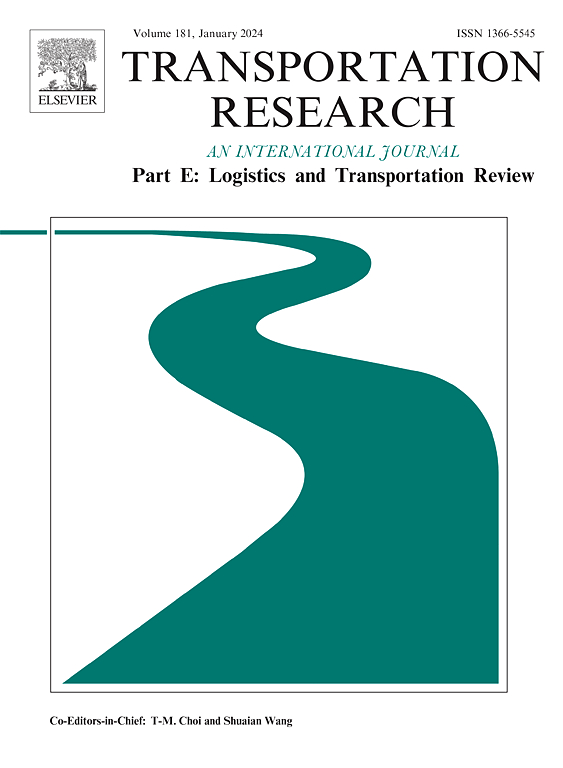捕获交通状态变化过程:一种分析建模方法
IF 8.3
1区 工程技术
Q1 ECONOMICS
Transportation Research Part E-Logistics and Transportation Review
Pub Date : 2025-04-18
DOI:10.1016/j.tre.2025.104119
引用次数: 0
摘要
准确、可靠的交通状态识别是优化交通系统的关键,是缓解交通拥堵、提高交通运行整体效率和稳定性的基础。现有研究主要采用信号处理方法和交通基础图等方法,但各有不足。因此,本研究引入了贝叶斯在线变化点检测方法,该方法可以动态检测交通流观测序列中的变化点,以解释包括交通流崩溃在内的交通状态变化过程。与传统方法相比,该方法更具灵活性和适应性。我们用这种方法进行实证分析。此外,基于改进的s型三参数(S3)基本图,提出了一种自适应多状态交通基本图模型来识别交通状态的变化。我们提出的交通状态识别方法具有高度的可解释性,可用于捕获最多由五种不同状态和四个密度参考值组成的交通状态特征。我们用这种方法进行理论分析。此外,本研究将上述两种方法应用于高分辨率车辆轨迹数据集,实现了对交通状态变化过程的全面分析。研究结果表明,两种技术检测到的交通状态具有很强的一致性,从而验证了我们的方法在交通流动态识别和分析方面的增强功效。通过对现场数据分析和理论分析结果的比较,对交通状态动力学有了更深入的了解,包括从自由流动状态到拥挤状态的转变,以及各种交通状态的特征,如稳定、亚稳态和不稳定阶段。本文章由计算机程序翻译,如有差异,请以英文原文为准。
Capturing traffic state variation process: An analytical modeling approach
Precise and dependable identification of traffic states is crucial for optimizing traffic system, which forms the foundation for mitigating congestion and enhancing the overall efficiency and stability of traffic operations. Existing research has mainly adopted methods such as signal processing methods and traffic fundamental diagrams, but each has its own shortcomings. Therefore, this study introduces a Bayesian online changepoint detection method, which can dynamically detect changepoints in traffic flow observation sequences to explain the progression of traffic state variation including traffic flow breakdown. This method is more flexible and adaptable compared to traditional methods. We use this method for empirical analysis. Moreover, this study proposes an adaptive multi-state traffic fundamental diagram model to identify changes in traffic states based on a modified s-shaped three-parameter (S3) fundamental diagram. Our proposed traffic state identification approach is highly interpretable, and can be used to capture traffic state features consisted of at most five different states with four density reference values. We use the method for theoretical analysis. Furthermore, this study applies the above two methods to a high-resolution vehicle trajectory dataset, achieving a comprehensive analysis of the process of variations in traffic state. The findings indicate a strong alignment in the traffic states detected by both techniques, thereby validating the enhanced efficacy of our methodologies for the recognition and analysis of traffic flow dynamics. By comparing the findings of field data analysis and theoretical analysis, a deeper understanding of the traffic state dynamics is achieved, which encompasses the transition from a free-flow condition to a congested one, along with the features of various traffic states such as the stable, metastable, and unstable phases.
求助全文
通过发布文献求助,成功后即可免费获取论文全文。
去求助
来源期刊
CiteScore
16.20
自引率
16.00%
发文量
285
审稿时长
62 days
期刊介绍:
Transportation Research Part E: Logistics and Transportation Review is a reputable journal that publishes high-quality articles covering a wide range of topics in the field of logistics and transportation research. The journal welcomes submissions on various subjects, including transport economics, transport infrastructure and investment appraisal, evaluation of public policies related to transportation, empirical and analytical studies of logistics management practices and performance, logistics and operations models, and logistics and supply chain management.
Part E aims to provide informative and well-researched articles that contribute to the understanding and advancement of the field. The content of the journal is complementary to other prestigious journals in transportation research, such as Transportation Research Part A: Policy and Practice, Part B: Methodological, Part C: Emerging Technologies, Part D: Transport and Environment, and Part F: Traffic Psychology and Behaviour. Together, these journals form a comprehensive and cohesive reference for current research in transportation science.

 求助内容:
求助内容: 应助结果提醒方式:
应助结果提醒方式:


